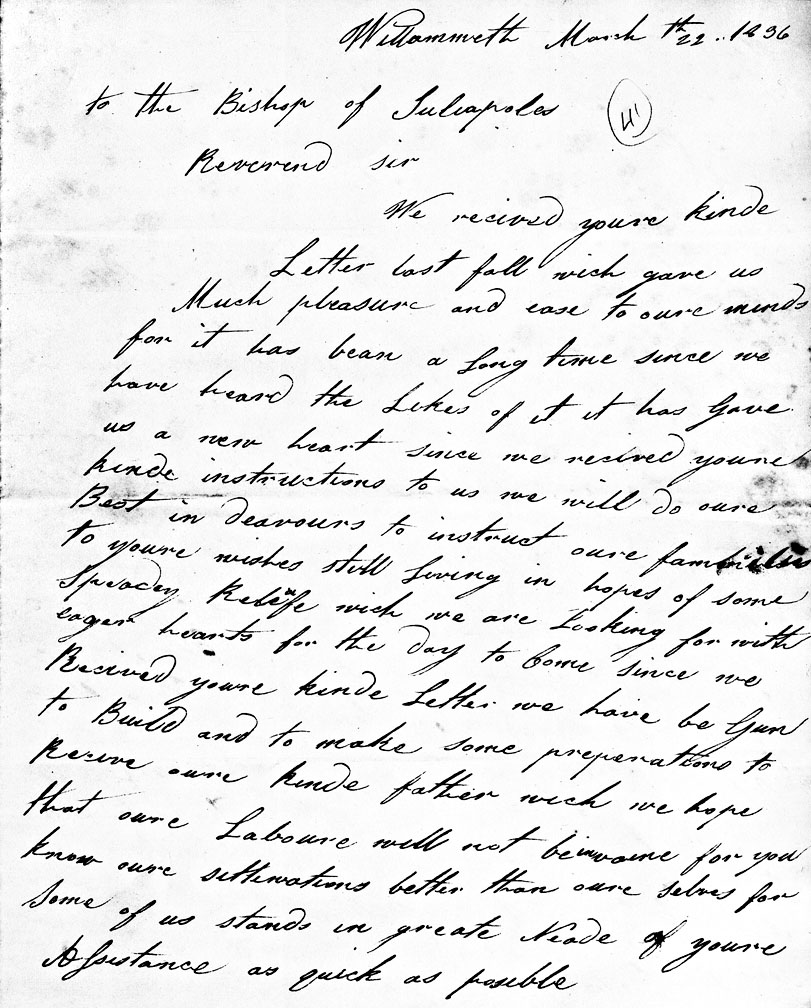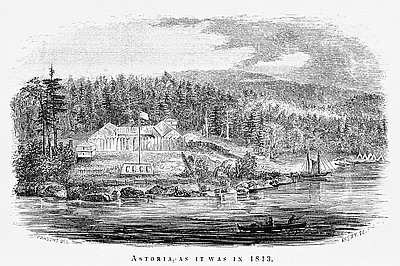- Catalog No. —
- Mss 83
- Date —
- 1836
- Era —
- 1792-1845 (Early Exploration, Fur Trade, Missionaries, and Settlement)
- Themes —
- Environment and Natural Resources, Religion
- Credits —
- Oregon Historical Society
- Regions —
- Oregon Country Willamette Basin
- Author —
- Joseph Gervais, et al
Willamette Settlers to the Bishop of Juliopolis
This dictated letter, written in semi-literate English, was sent by eighteen male settlers in the mid-Willamette Valley to Joseph Provencher, the Catholic bishop at Red River, Manitoba, then known as the Bishop of Juliopolis. Provencher was the closest Roman official to the Oregon Country at that time.
The settlers included sixteen French Canadians, a French-Algonquin, and an individual of Irish or Scottish ancestry. All were former fur trappers who had worked for the various fur trade companies that had operated in the Oregon Country: John Jacob Astor’s Pacific Fur Company (1811-1813), the North West Company (1813-1822), and the Hudson’s Bay Company (beginning in 1822). The trappers working for the Pacific Fur Company, known as Astorians, first ventured into the Willamette Valley in 1812. Over the decades, they established trade and kin relations with the Kalapuyans, the valley’s indigenous inhabitants. Around 1830, several of the original Astorians, including Jean-Baptiste Desportes McKay and Joseph Gervais, settled permanently in the mid-Willamette Valley with their Indian wives and children—likely with the permission of the local Kalapuyans, the Ahantchuyuk.
By the mid-1830s, the French-Indian settlement had grown to roughly twenty families, and as a result, the settlers decided to request that French Canadian Catholic missionaries be sent to Oregon. The settlers dispatched two letters, now lost, in 1834 and 1835 to Bishop Provencher. However, Provencher was unable to send missionaries due to his own shortage of priests in Manitoba and a lack of support from the Hudson’s Bay Company. The first Protestant missionaries to Oregon, American Methodists headed by Jason and Daniel Lee, arrived in the fall of 1834 and established a small mission several miles north of present-day Salem, Oregon, not far from the farm of Joseph Gervais. Although the French-Indian families welcomed the Methodists by assisting in the construction of a mission and sending their children to be educated at the mission, they remained determined to see a Catholic mission in the area.
In 1837 the settlers sent a fourth and final letter to Joseph Provencher, stressing the need for Catholic clergy. In the fall of 1838, the first Catholic missionaries, Francis N. Blanchet and Modeste Demers arrived from Quebec. Blanchet established a permanent mission in the center of the French-Indian settlement, now the town of St. Paul, Oregon, a year later in the fall of 1839.
Further Reading:
Munnick, Harriet D.“Biographical Annotations.” In Catholic Church Records of the Pacific Northwest. Vol. 2 St. Paul, Oregon, 1839-1898. Portland, Oreg., 1979.
McKay, Harvey J. St. Paul, Oregon, 1830-1890. Portland, Oreg., 1980.
Written by Melinda Jette, © Oregon Historical Society, 2003.

